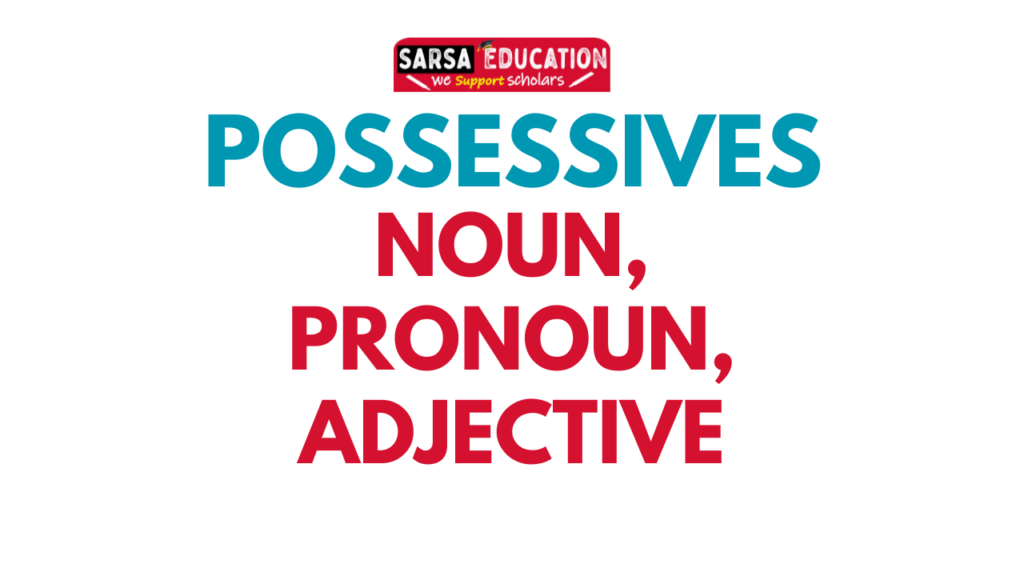Contents
Possessives
Possessives show ownership.
Possessive Nouns
A possessive noun shows ownership. Add ’s to make a singular noun show ownership. Add an apostrophe (’) after the s of a plural noun to show ownership.
A possessive noun shows ownership. Add ’s to make a singular noun show ownership. Add an apostrophe (’) after the s of a plural noun to show ownership.
Read also: Worksheet Possessive
- To form the possessive of a singular noun, add ‘s. Example: (boy’s)
- To form the possessive of a plural noun ending in -s, add an apostrophe. Example: (girls).
- To form the possessive of a plural noun that does not end in -s, add ‘s. Example: (men’s)
Singular possessives (Noun) – Examples:
- The computer’s screen is flickering.
- The king’s palace is beautiful.
- The singers’ voices are very beautiful.
- The man’s shoe collection is impressive, he has hundreds.
Plural possessives (Nouns) – Examples:
- The boys’ toys are scattered all over the playground.
- The girls’ books are filled with adventure and magic.
- The men’s shoes are polished and ready for the big night.
Read also: Day 2: Nouns
Read also: Day 3: Pronouns
SINGULAR PLURAL
Noun Possessive Plural Possessive
Man man’s men men’s
woman woman’s women women’s
child child’s children children’s
- There are three types of –s endings:
- Plural only -s
- Possessive only -’s
- Plural possessive -s’
2. The spelling of the various possessive -s is very consistent, which is one of the great things about writing them. For instance, the possessive forms of irregular nouns that transform f to v in the plural are spelled as follows:
- Singular: wolf
- Possessive: wolf’s (note that the f does not change to v)
- Plural: wolves
- Plural possessive: wolves’
3. Here is how we spell the possessives of nouns ending in consonant + y:
- Singular: spy
- Possessive: spy’s
- Plural: spies
- Plural possessive: spies’
4. Notice that the plural spies is spelled differently than the possessive singular spy’s. In the singular possessive, the y does not change to i and we do not add –es. We just add the normal -’s.
Here is how we spell the possessive nouns ending in vowel + y:
- Singular: boy
- Possessive: boy’s
- Plural: boys
- Plural possessive: boys’
Keep in mind that since the y is a part of the vowel’s spelling, it remains unaltered.
Possessive Pronouns
Possessive pronoun shows ownership or possession without using a noun. It replaces a possessive noun.
Singular possessives (Pronouns):
(Mine, Yours, His, Hers)
Examples:
- The book is mine, and I’m not lending it to anyone.
- The gift is yours, and I hope you like it.
- The car is his, and he’s very proud of it.
- The painting is hers, and it’s a beautiful piece of art.
Plural Possessives (Pronouns):
(Ours, Yours, Theirs)
Examples:
- The house is ours, and we’re excited to move in.
- The success is yours, and you deserve to celebrate.
- The award is theirs, and they worked hard to earn it.
Read also: Day 4: Singular and plural forms of nouns
Read also: Worksheet Possessive
Read also: Day 6: A, some, any – countable and uncountable nouns
Possessive Adjectives
When you want to talk about something that belongs to someone or something, you use a possessive adjective. A possessive adjective answers questions related to ownership such as:
- Whose house is this? (Answer: My/Mine)
- Whose books are these? (Answer: Hers/Hers)
- Whose television is that? (Answer: His/His)
Possessives
| Subject Pronoun | Possessive Adjective | Example |
| I | My | My house is on park Avenue |
| You | Your | Do you have your phone with you? |
| He | His | Nick loves his father’s cooking. |
| She | Her | Her purse is very stylish. |
| It | its | A butterfly flutters its wings beautifully. |
| We | Our | We spend all our free time on computers. |
| They | Their | The students will share their favorite CDs. |
For regular English-speaking course updates, kindly join our Telegram channel
Follow the Sarsa Education channel on Telegram: https://shorturl.at/R5WKa

